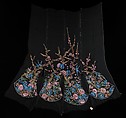Textile piece
Textile design attributed to Sarah Lipska Polish
Not on view
This object is from a collection of sample embroideries, which was originally owned by Morris de Camp Crawford, editor of Women's Wear Daily, who collected objects which told the story of fashion and fabric history. Included in this collection was a group of textiles which illustrated what American and French designers and manufacturers were using. According to Crawford's book The Ways of Fashion, the work of Polish artist Sarah Lipska (1882-1973) was represented in this collection. Lipska is an enigmatic figure, who is known to have worked with Leon Bakst as a set and costume designer for the Ballets Russes, and later in the 1920s as a fashion designer in Paris at 4 rue Belloni, and finally as a sculptor. Extant examples of her work are rare. Although only a few pieces in the Brooklyn Museum collection bear a label or a signature, others bear hallmarks of her work, such as a distinctive form of whip stitching on appliqué work, unusual abstract motifs, and Cubist-inspired patterns.
The French dressmaking industry is unparalleled in the variety of trimmings used in their creations. This particular piece of embroidery on what probably would have been a dress hem is a magnificent example of that tradition. The variety and detail of the beads and paillettes used here make for an overall vibrant and stunning visual effect. The texture of the crimped brown sequins helps to create the effect of branches, while the use of flower head paillettes for the flower centers is witty. The two-tone green floss used to interpret the water is particularly effective. The variant colors and textures mimic light bouncing on the surface of rippling water above a lush underwater forest.
This image cannot be enlarged, viewed at full screen, or downloaded.
This artwork is meant to be viewed from right to left. Scroll left to view more.



